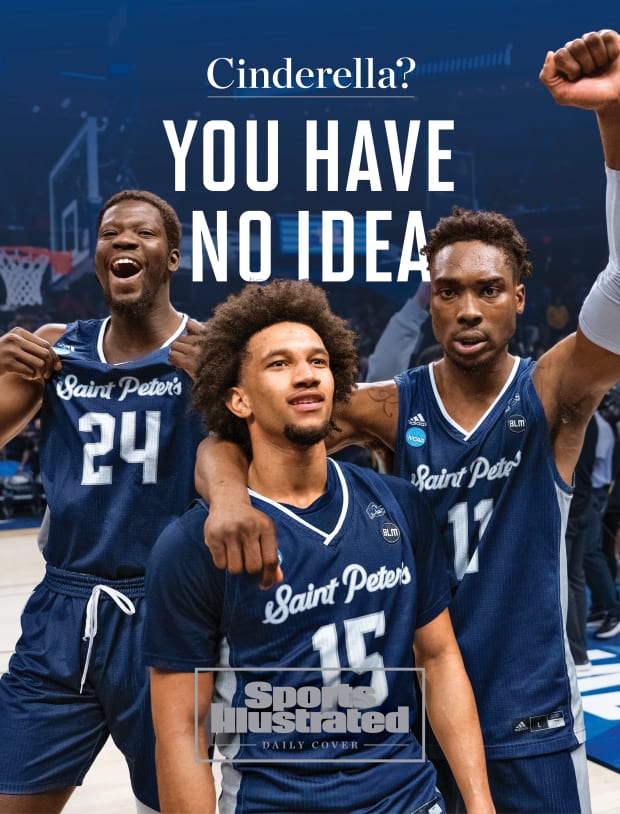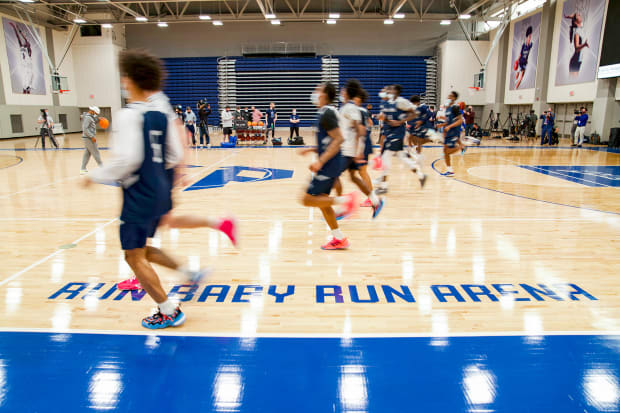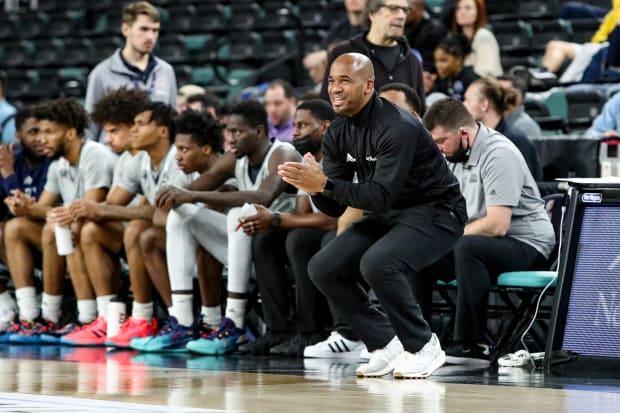Butler. Davidson. VCU. Florida Gulf Coast. UMBC. Oral Roberts.
Saint Peter’s?
Last week the Peacocks joined the list of schools who have etched themselves into March Madness folklore. Many rose from small—and even obscure—backgrounds, their programs suddenly thrust to the national forefront in a way that only this event allows in sports.
Saint Peter’s introduction to the college basketball world came on the first full night of the 2022 men’s NCAA tournament, when it knocked off juggernaut Kentucky in one of the greatest upsets in the tourney’s history. It then followed it up by beating fellow mid-major Murray State, becoming just the third No. 15 seed to ever reach the Sweet 16.

Zach Bolinger/Icon Sportswire/Getty Images
But Saint Peter’s isn’t your average Cinderella, and its path was more difficult than that of Davidson, or Oral Roberts, or UMBC. Coaches and players who’ve spent time at the school, and opposing teams who’ve played against the Peacocks, can tell you all about the challenges presented in building a program at a place with as limited resources as Saint Peter’s. From significant budget constraints to repeated flooding in the basketball offices to swimmers in Speedos walking through the visiting locker room on game days, the stories from the last decade paint a picture of a program that has had to overcome plenty to get into this remarkable position, where it will play Purdue on Friday for what would be an unprecedented spot in the Elite Eight.
They also show how coach Shaheen Holloway has navigated one of college basketball’s toughest jobs, setting a new foundation and helping the Peacocks rise to new heights.
Holloway and administrators like current athletic director Rachelle Paul and former AD Bryan Felt had the program improving well before the Peacocks became national darlings last week. But since Saint Peter’s may never have some of the luxuries even its conference rivals have, coaches who’ve experienced life with the program marvel at the work they’ve done to put the school on the map.
“Compared to anyone else in the league, everyone else [in the MAAC] should be fired,” a former assistant at Saint Peter’s says. “The resources that anyone else in the MAAC has … what Shaheen is doing right now is unheard of. He should get a $10 million job, for real.”
The Challenges
Major budgetary limitations
It’s one thing to compare Saint Peter’s budget to that of Kentucky, the team the Peacocks upset in the first round of the Big Dance. Among the many statistics that quantify the chasm between the Wildcats and Peacocks: Kentucky head coach John Calipari’s annual salary ($8.5 million) is more than five times Saint Peter’s annual men’s basketball expenditures (just under $1.6 million).
More instructive is comparing Saint Peter’s to other familiar Cinderella teams. The below chart compares the Peacocks’ operating expenses in men’s basketball with a trio of familiar mid-majors who’ve pulled upsets in the Big Dance: UMBC, Oral Roberts and the Peacocks’ second-round opponent, Murray State.
Even compared to other mid- and low-major programs, Saint Peter’s stands out for its lack of resources. Its operating expenses are 60% of Murray State’s, a school that has won NCAA tournament games in two of the last three tournaments. One key area where the Peacocks spend far less than the competition is in recruiting. Per Department of Education data, Saint Peter’s spends $28,588 on recruiting expenses for all its men’s sports teams combined. All three of our above Cinderellas spent at least three times that number on men’s sports recruiting.

Limited staff resources
In Division I, teams are allowed three assistant coaches on the road recruiting. But until very recently, Saint Peter’s only budgeted for two paid assistants, meaning that the team’s third assistant was technically a volunteer who wasn’t paid. Having an unpaid assistant is very rare in men’s D-I basketball. The Peacocks’ director of basketball operations position was also unpaid throughout John Dunne’s time as the school’s head coach, a tenure that spanned from 2006 to ’18. These positions also didn’t include things like college credits or free classes, which some programs provide as part of what’s called a “graduate assistant” position.
Ryan Patrick Woerner was one of the many Peacocks coaches over the years to work as an unpaid assistant, he says. In order to make ends meet, he picked up odd jobs like refereeing CYO basketball games and substitute teaching in New York City public schools, though he said it was difficult to take on extra work and pay the bills because of the demanding hours of working as a full-time assistant coach.
“Our role there was like, first to come in, last to leave,” Woerner says.
One common way coaches make additional money is staffing summer camps. But given Saint Peter’s location in Jersey City, it doesn’t host camps. Woerner worked camps at other area programs, like Columbia, to help make ends meet, but still said he was running “a significant deficit” financially while working with the Peacocks.
Office issues
As a recent Twitter thread Woerner made to shed light on the improbability of the Peacocks’ incredible run noted, flooding was a common occurrence in the basketball coaching offices because of its location inside Yanitelli Center. The offices at the time were located below the “tennis bubble,” an air-supported roof that enclosed the tennis courts on top of the rec center. As a result, when snow would melt, water would leak down through into the cramped staff office, pictured below.
The temperature also fluctuated drastically in the offices based on the weather.
“It was either really cold or really hot,” says one former assistant coach, who also spoke of regular office flooding during his tenure on staff with the Peacocks. He describes one time when he sat in the office wearing a winter coat and gloves to stay warm while attempting to get work done.

Danielle Parhizkaran/NorthJersey.com/USA Today Network
Shared spaces
One of the problems with running a program at the lowest levels of D-I is sharing your arena with the rest of campus and in some cases, the community. It’s why programs even in Saint Peter’s conference, like Siena, have built practice facilities used specifically for the basketball programs, giving players and coaches 24/7 access to a gym.
At Saint Peter’s, Yanitelli Center is a shared space, used for everything from intramural games to other varsity practices to community events with bounce houses and bake sale stands. With that come all kinds of issues, from minor things like floor damage from bad footwear use to court-scheduling conflicts that caused the team to put up curtains or dividers to practice while sharing the court with the rest of the campus community. And perhaps more serious, one former staffer recalled a time when all the team’s basketballs were stolen from the equipment closet.
“A student asked if he could use a basketball one day. … He saw where we put it, and the next day when we went to get the ball rack out, the chain on the rack was broken and all the basketballs were gone,” the coach says.
The team did find a basketball in the office to use for practice that day, but it was still a moment rather unbecoming of a serious D-I program.
The visitor’s locker room
Pretty much any MAAC coach or player has a story or two about playing on the road at Saint Peter’s. Before the school renovated its arena ahead of the 2021–22 season, road teams would often encounter the general public in and near the visitor’s locker room. Why? The pool, which Woerner wrote was rented out “to any paying customer,” was close to the locker room and press conference area. One opposing MAAC coach recalls a few times over the years his team changed in the locker room while swimmers in Speedos walked through to take a shower.
Woerner has more dramatic stories, including when a pipe burst and flooded the hallway to the visiting locker room while Canisius was in town. The hot water stopped working when Loyola Chicago came to town for a pre-Christmas matchup back in the 2012–13 season, which several former Ramblers chimed in on Twitter to confirm.
A leaky ceiling
Office flooding wasn’t the only water issue over the years at Saint Peter’s. The roof in the team’s gymnasium also leaked at times. The most notable example came in January 2016, when a nationally televised game against Manhattan was postponed because of leakage attributed to melt-off from Winter Storm Jonas. For a program that was rarely if ever on national television before its Sweet 16 run, having a game like that postponed was quite the disappointment.
The leaks still happened intermittently over the years. Former Saint Peter’s assistant Matt Eisele, who worked at the school from 2018 to ’21, recalls leaks during individual workouts shortly after Holloway took the job.
“In the middle of workouts, we had to relocate the trash cans to where the holes from the top of the arena were dripping down water so the kids wouldn’t slip and fall,” Eisele says. “Every time when we were in the middle of a drill, we’d have to move the trash cans so the water wouldn’t get near the kid.”
“Those were pretty good days.”
Name recognition … or lack thereof
The phrase “put the school on the map” may be cliché this time of year, but one lasting result of this tournament run will be making everyone from casual fans to New Jersey residents to potential recruits aware of what and where Saint Peter’s is.
Even though the staff recruited local players from within driving distance (partially due to budget constraints), there was very little public knowledge about the school. Coaches had told prospective recruits that it was Division I and that it competes with the likes of Iona, Monmouth and Siena in its conference.
“I would say, in the beginning part of the process, probably 80% of our roster didn’t even know who Saint Peter’s was until we started recruiting them,” Eisele says.

Thomas Salus/USA TODAY Sports
So how did Saint Peter’s become a most extraordinary Cinderella?
It starts with Holloway, whose four-year tenure has produced the longest sustained run of success the program has seen since the late 1980s—and that was before knocking off Kentucky and Murray State. Under previous coach Dunne, it essentially had a life cycle: struggle for two years while young players gained experience, then have success for a year or two with an older roster. That success led to an NCAA tournament berth in 2011 and a CIT championship in ’17, but not the sustained success Holloway has brought after a 10–22 mark in Year 1.
It wasn’t just Holloway who helped improve things in Jersey City. Felt, the athletic director who hired Holloway at Saint Peter’s before leaving for the same position at Seton Hall in 2019, and current AD Paul (who came from Seton Hall) helped make incremental improvements to the department and the men’s basketball program in particular. Even before the team’s arena was renovated into what is now Run Baby Run Arena (a far more respectable D-I facility), smaller upgrades like locker room and office renovations built a “trust factor” between Holloway and recruits, current players and AAU coaches in the area, Eisele says.
Additional program upgrades, like paying a third assistant coach and other operational improvements, were made possible in part by playing more “guarantee games” during the nonconference portion of the Peacocks’ schedule. Guarantee games are road games played against higher-level competition that smaller schools like Saint Peter’s get paid for playing, often on the order of $80,000 or more. Holloway scheduled four such games in his first season and three in his second.
Eisele says these games had a dual purpose: Not only did they give the program a bit more breathing room from a budget standpoint, but they also served as recruiting tools because they gave the team games on national television. Saint Peter’s couldn’t sell the bells and whistles that other mid-major programs in the area could, but the chance to compete on the big stage and get national exposure was one area where the Peacocks could get an edge. Holloway and Eisele (his recruiting coordinator) shrank their recruiting board from the usual 50–60 prospects a school at Saint Peter’s level would have down to about half—25–30 kids who seemed willing to buy into their vision and were more focused on winning than a fancy gym or a big campus. Then, they went to work selling the school to those prospects.
“We outworked everybody,” Eisele says. “Sha outworked everybody. I know that sounds cliché, but when you’re in a situation like that, it’s either roll up your sleeves and outwork everybody, or you’re just going to get the traditional mediocrity.”
The sales pitch was focused around player development. Recruiting visits started becoming centered on making sure prospects saw the team watch film and do individual workouts, rather than the fancy dinners and long campus tours you might get elsewhere. Holloway and his staff made sure to surround recruits with the people on campus who shared their vision for the program. And, importantly, they brought in players who wanted to prove people wrong.
“Some of the guys on my team think they’re supposed to be at Kentucky,” Holloway said last week. “When they get a chance to play against teams like that, they play with a chip on their shoulder; they got something to prove.”
The pitch worked. So many of the stars of this improbable run, guys like Daryl Banks III, Doug Edert and the Drame twins, came in together as freshmen as part of Holloway’s first full recruiting class as coach of the Peacocks. And in three years on campus, that class has twice won 14 MAAC games, a feat the program achieved just once prior to their arrival.
Going to the Sweet 16 may not transform Saint Peter’s into a basketball powerhouse. The resources there may never match even MAAC rivals—in fact, it would be surprising if they did. But this truly magical run serves as a reminder that anything is possible in the NCAA tournament. With the right coach and players who buy into that coach’s vision, there’s a chance Cinderella’s slipper will fit.
If Saint Peter’s can do it, your school can, too.







